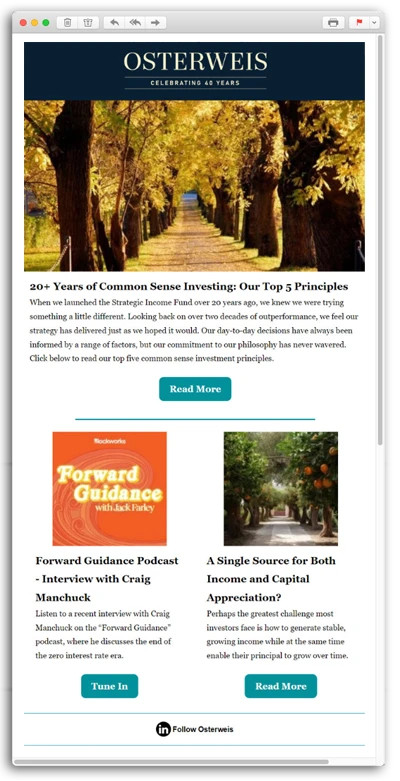Second Quarter Strategic Income Outlook
Published on April 11, 2024
Despite elevated interest rates, economic conditions improved throughout the first quarter, creating a favorable near- to medium-term outlook.
Rip Van Winkle Would Be Confused
If Rip Van Winkle awoke from a 15-month slumber today, we believe he would be quite surprised by the state of the economy. At the end of 2022, markets were on edge following a historically challenging year, and the consensus view was that higher rates would slow economic activity, forcing the Fed to cut rates sooner rather than later despite its battle with inflation. The vast majority of economists were forecasting some type of recession, though some were anticipating a hard landing while others were expecting a softer one. Of course, as a wise man once pointed out, economies are not airplanes, so they do not land or stop. Rather, economic cycles are continuums that evolve and change.
Fast forward to today, and we can see why Van Winkle might be disoriented. Not only is the fed funds rate unchanged from its peak, but equity markets are at their all-time highs, unemployment remains below 4%, and talk of Fed cuts has ebbed. Perhaps more importantly, inflation has eased, though it is still above the Fed’s 2% target, and the focus now is mostly on the last mile: getting inflation from the 3% area down to 2%. Van Winkle would undoubtedly be wondering how so many “professionals” got their forecasts so wrong.
Maybe it is because attracting attention in such a crowded field sometimes calls for outlandish predictions, regardless of their eventual accuracy. For example, in December 2023, UBS’s chief economist was predicting nine Fed rate cuts (225 basis points!) by the end of 2024, while the general market expectation was for six cuts over the same time period. While we’re only one quarter into the new year, the Fed has made zero cuts so far, and we have an election coming up in November, so time seems short to make bold moves (barring an exogenous event). Let us take a look at some of the variables that are causing the Fed to sit on the sidelines and what it means for investors.
Following a small dip in January due to severe winter weather, consumer spending has rebounded in February and Evercore ISI estimates that for the first quarter 2024 it will be up 2.5%. Consumers do not seem to be slowing down their purchasing, though the mix is more heavily weighted to services than durable goods. Driven by low unemployment and the wealth effect from the stock market, household debt service as a percentage of disposable income has been well below the last 40-year average. In addition, prices of bigger ticket items like autos (both used and new) and household appliances have been coming back down. As mortgage rates have ticked down lately, we are seeing housing starts increase and existing home sales improve due to pent up demand and creative mortgage rate buydown schemes by homebuilders. Both are multipliers to economic activity.
Still, some caution is warranted as Strategas Research’s Common Man CPI has been higher than the Fed’s CPI calculation. Strategas calculates items that consumers must buy as opposed to what they might buy. Likewise, Jim Bianco of Bianco Research highlights the growth in consumer credit card debt and home equity lines of credit as warning signs that consumer spending may be getting ready to slow. This is something that bears watching.
Similar to consumers, corporate spending has not been held back by interest rates so far. Our friend John Silvia of Dynamic Economic Strategy notes that the National Financial Conditions Index has been indicating increasingly easier conditions since April 2023. For smaller firms, commercial and industrial loan standards have also been easing for the last six months. In the aftermath of the Covid supply chain disruptions and subsequent price spikes/heavy consumer spending, companies have been able to continue to raise prices. And once they put in price increases, CEOs are loath to reduce them until they are forced to do so by pricing pressures from competitors. So far there are precious few signs of that happening. So, until the economy or the consumer cracks, we will continue to see companies enjoying their long absent pricing power. This may be why Strategas Research is forecasting S&P 500 Operating Margins rising to 16.9% and earnings growth of 10.7% in 2024 and 13.3% in 2025.
In addition, corporate treasurers have used the robust capital markets to tear down the maturity wall by refinancing shorter-term debt. As Bank of America’s high yield fixed income strategist Oleg Melentyev reports, over the last 12 months the market has seen a reduction of 40% of near-term maturities. Per Melentyev, “This episode represents one of the most aggressive instances of maturity extension in the history of leveraged finance.” We would note though that the majority of this refinancing has been focused mostly on the high and mid-quality segments. The lower and lowest quality segments have remained constrained in their ability to refinance, something we continue to watch and one more reason to stay in higher quality and to really know your credits in this environment.
While some caution may be warranted regarding consumer and corporate spending, the real issue vexing the Fed is government spending. For all the balance sheet runoff (quantitative tightening) that the Fed is conducting, it is being undone by other federal borrowing and spending. In the fourth quarter of 2023, U.S. GDP grew $334 billion while at the same time the federal debt grew $834 billion. Government spending was the largest input to GDP growth in the same period. It does not look like this will change with either candidate currently running for President. Whether it is infrastructure spending, additional government assistance, or tax cuts, the deficits will likely continue to spiral upwards as will the national debt.
A National Bank of Canada (“NBC”) study predicts that as a percentage of GDP, U.S. debt will breach the post WWII high water mark (about 105% in the 1940’s) within the next decade and it is forecasted to continue to grow after that. The NBC estimates that U.S. public debt will triple over the next 20 years. This means larger treasury auctions over time and presumably upward pressure on interest rates as supply swamps demand, countering the relative calm the Fed has engineered so far. Over the next 30 years, the net interest expense of the U.S. will rise to approximately 20% of federal spending. Coupled with social security, health care, defense, and other mandatory spending this will total approximately 80% of federal spending. As Paul Donovan at UBS explains, “The US separation of powers combined with political polarization makes deficit control difficult. Members of Congress decorate the budget with baubles of tax breaks and spending that favor their own constituency.”
There is a bright spot though. As Bill King from M. Ramsey King Securities points out, “the U.S. federal government took in taxes/revenue of almost $4.5 trillion dollars last fiscal year. This is more than the GDP of every country on earth, other than our own and China's.” We have the revenue, but clearly, we have a spending problem that Congressional leaders will need to address in the coming decades. Another positive is that the Millennial and Gen Z generations are each larger than the Baby Boomers, so as long as they are working and paying taxes, there should be additional funding for some time. In addition, the wealth transfer from Baby Boomers should help compensate the younger generations as they confront the demands of the federal budget deficit.
Given that current interest rates have not cratered consumer spending and corporate profits are continuing to grow, market participants have been steadily reducing the number of cuts they have estimated for the fed funds rate this year. From nine cuts at the extreme, most economists are now predicting three on average before the end of the year and more are joining the less than three and possibly no cuts camp. Similarly, the dot plots from the most recent FOMC meeting are projecting three cuts by the end of the year, although they have been a notoriously inaccurate predicter of future interest rates. For example, in March 2022, the dot plot estimated that the fed funds rate would have been below 3% by the end of 2023. Enough said. As we mentioned above, further complicating the Fed’s tightening policy is that 2024 is a Presidential election year. The Fed wants to be and look apolitical, so as the calendar approaches August/September, it will be reluctant to make any moves, lest the candidates use its action or inaction as a rallying cry. Regardless, the Fed is in a bind. Cut too early while the economy is still healthy and risk a return of inflation or wait and cut too late (as is its longstanding tradition) and risk harming the economy. Stay tuned!
So how does one invest when the economy continues to confound the Fed, Congress is not helping the situation with deficit spending, and a Presidential election is looming? We believe the best path is to drown out the noise and focus on what is attractive today rather than make a bet favoring one outcome over another. If Rip Van Winkle teaches us anything, it is that a lot can change in a short period of time. Fortunately, the inverted curve continues to provide us with a historic opportunity for favorable risk-adjusted returns. On March 20, 2024, the 2-year vs. 10-year yield curve became the longest continuous inversion since 1978, and we think the inversion may last for a while longer. As investors we are always looking for the most attractive securities while minimizing the amount of risk we take. The higher rates at the short end are giving us ample opportunity to capture solid yields while we wait for the Fed’s next steps. If it turns out that the economy is easing into an extended period of slow but steady growth, we are fine continuing to focus on the shorter end. If we hit an iceberg and the economy and markets sink, we will be in a good position to lock in higher yields on longer-dated bonds as they sell off.
We thank you for your continued confidence in our management.
Carl Kaufman
Co-President, Co-Chief Executive Officer, Chief Investment Officer – Strategic Income & Managing Director – Fixed Income
Bradley Kane
Vice President & Portfolio Manager – Strategic Income
Craig Manchuck
Vice President & Portfolio Manager – Strategic Income
John Sheehan, CFA
Vice President & Portfolio Manager – Strategic Income
The Fund was rated 4 Stars against 592 funds Overall, 4 Stars against 592 funds over 3 Years, 5 Stars against 538 funds over 5 Years, 4 Stars against 424 funds over 10 Years in the High Yield Bond category based on risk-adjusted returns as of 2/28/25.
The Morningstar Rating™ for funds, or “star rating,” is calculated for mutual funds, variable annuity and variable life subaccounts, exchange-traded funds, closed-end funds, and separate accounts) with at least a three-year history. Exchange-traded funds and open-ended mutual funds are considered a single population for comparative purposes. It is calculated based on a Morningstar Risk-Adjusted Return measure that accounts for variation in a managed product’s monthly excess performance, placing more emphasis on downward variations and rewarding consistent performance. The top 10% of products in each product category receive 5 stars, the next 22.5% receive 4 stars, the next 35% receive 3 stars, the next 22.5% receive 2 stars, and the bottom 10% receive 1 star. The Overall Morningstar Rating for a managed product is derived from a weighted average of the performance figures associated with its three-, five-, and 10-year (if applicable) Morningstar Rating metrics. The weights are: 100% three-year rating for 36-59 months of total returns, 60% five-year rating/40% three-year rating for 60-119 months of total returns, and 50% 10-year rating/30% five-year rating/20% three-year rating for 120 or more months of total returns. While the 10-year overall star rating formula seems to give the most weight to the 10-year period, the most recent three-year period has the greatest impact because it is included in all three rating periods.
© 2025 Morningstar. All Rights Reserved. The information contained herein: (1) is proprietary to Morningstar and/or its content providers; (2) may not be copied or distributed; and (3) is not warranted to be accurate, complete or timely. Neither Morningstar nor its content providers are responsible for any damages or losses arising from any use of this information. Past performance does not guarantee future results.The Osterweis Funds are available by prospectus only. The Funds’ investment objectives, risks, charges, and expenses must be considered carefully before investing. The summary and statutory prospectuses contain this and other important information about the Funds. You may obtain a summary or statutory prospectus by calling toll free at (866) 236-0050, or by visiting www.osterweis.com/statpro. Please read the prospectus carefully before investing to ensure the Fund is appropriate for your goals and risk tolerance.
Mutual fund investing involves risk. Principal loss is possible.
Past performance does not guarantee future results.
This commentary contains the current opinions of the authors as of the date above, which are subject to change at any time, are not guaranteed, and should not be considered investment advice. This commentary has been distributed for informational purposes only and is not a recommendation or offer of any particular security, strategy, or investment product. Information contained herein has been obtained from sources believed to be reliable but is not guaranteed.
No part of this article may be reproduced in any form, or referred to in any other publication, without the express written permission of Osterweis Capital Management.
Current and future holdings are subject to risk.
A basis point is a unit that is equal to 1/100th of 1%.
Yield is the income return on an investment, such as the interest or dividends received from holding a particular security. A yield curve is a graph that plots bond yields vs. maturities, at a set point in time, assuming the bonds have equal credit quality. In the U.S., the yield curve generally refers to that of Treasuries.
Spread is the difference in yield between a risk-free asset such as a Treasury bond and another security with the same maturity but of lesser quality.
The S&P 500 Index is widely regarded as the standard for measuring large cap U.S. stock market performance. The index does not incur expenses, is not available for investment, and includes the reinvestment of dividends.
The fed funds rate is the rate at which depository institutions (banks) lend their reserve balances to other banks on an overnight basis.
Consumer Price Index (CPI) reflects the weighted average of prices of a basket of consumer goods and services, such as transportation, food, and medical care. There is typically a one-month lag in the measure due to the release schedule from the U.S. Bureau of Labor Statistics.
Strategas’ Common Man CPI is a subset of the goods and services within the CPI basket that the economics firm Strategas believes are staples (i.e., required purchases) rather than discretionary (i.e., optional). It is a proprietary metric.
The National Financial Conditions Index (NFCI), published by the Chicago Fed, provides a comprehensive weekly update on U.S. financial conditions in money markets, debt and equity markets, and the traditional and “shadow” banking systems.
Gross Domestic Product (GDP) is the monetary value of all the finished goods and services produced within a country’s borders in a specific time period.
Osterweis Capital Management is the adviser to the Osterweis Funds, which are distributed by Quasar Distributors, LLC. [OCMI-523339-2024-04-05]








